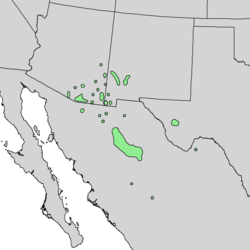From Wikipedia
Open on Wikipedia
| Quercus hypoleucoides | |
|---|---|

| |
| Scientific classification | |
| Kingdom: | Plantae |
| Clade: | Tracheophytes |
| Clade: | Angiosperms |
| Clade: | Eudicots |
| Clade: | Rosids |
| Order: | Fagales |
| Family: | Fagaceae |
| Genus: | Quercus |
| Subgenus: | Quercus subg. Quercus |
| Section: | Quercus sect. Lobatae |
| Species: | Q. hypoleucoides
|
| Binomial name | |
| Quercus hypoleucoides | |

| |
| Natural range of Quercus hypoleucoides | |
| Synonyms[3] | |
| |
Quercus hypoleucoides, the silverleaf oak or the whiteleaf oak, is a North American species of oak tree or shrub. It grows in the southwestern United States and northern Mexico.[4][5]
Description
[edit]Quercus hypoleucoides, though usually seen as a shrub, can be found to be a full-sized tree, 9 metres (30 feet) tall in areas where it receives sufficient water.[6][7]
The tree produces its flowers in the spring as most plants do.[8] It grows in warm regions and is used as an ornamental due to its unusual foliage.[9]
- Bark: Is dark gray in color. It is thin with shallow, lighter-colored fissures and narrow ridges.[8]
- Twig: Reddish brown in color and are broadly triangular with a sharp point. Are slender to moderate, generally with white fuzz. The end buds are clustered.[8]
- Leaves: Are alternate, evergreen, simple, and narrowly oblong to lanceolate. They are usually 5–10 centimetres (2 to 4 inches) long, with edges revolute. Occasionally there are a few shallow teeth, a narrow pointed tip, and a leathery texture. They are usually a shiny yellow-green on top and white or silvery on the bottom.[8]
- Fruits: Oblong acorn that is 1.5–2 cm (1⁄2–3⁄4 in) inch long. The cap is scaly bowl-shaped and covers one-third of the nut which ripens in 1 (or 2 seasons), maturing in early fall.[8]
- Flowers: Q. hypoleucoides is a monoecious plant, with both male and female flowers growing on the same plant. This is opposed to dioecious plants where male flowers and female flowers grow on separate trees. The male flowers form long drooping catkins that are yellow-green in color. The female flowers have very small spikes in leaf axils that appear with the leaves.[8]
- Form: Though usually found as a shrub, given enough moisture it can become a medium-sized tree that reaches up to 18 m (60 ft) tall with a spreading round crown.[10]
Q. hypoleucoides can be distinguished from other oaks by its lanceolate leaves which are dark green on top but silver white on the lower surface.[6][7]
Taxonomy
[edit]Its species name, hypoleucoides, means "white underneath", referring to the leaves.[6] It has been referred to as Quercus hypoleuca Engelm., an illegitimate name, and as Quercus confertifolia Torr., not to be confused with Quercus confertifolia Bonpl.[3]
Distribution and habitat
[edit]The species is commonly found in moist canyons and on ridges.[8] It also is found in coniferous forests and high elevated lands from 1,500–2,400 m (5,000 to 8,000 ft) above sea level.[6] Mountains of southern Arizona and New Mexico such as the Santa Catalina Mountains and the Chiricahua Mountains, for example, have a pine-oak woodland at an elevation of roughly 1,710–2,160 m (5,700 to 7,200 ft). Here, Q. hypoleucoides can be found as well as other species of oak trees such as the Q. arizonica, Q. emoryi, and Q. rugosa.[11]
Specimens have also been collected south of the international frontier, in Sonora, Chihuahua, Coahuila, and Sinaloa.[5]
Ecology
[edit]This species has acorns which are eaten by both squirrels and birds.[6] The taller trees also help to provide shade for animals below who need to get away from the strong rays of the sun.
It is a vigorous post-fire resprouter and will form a multi-stem shrub in areas of repeated fire.[12]

Uses
[edit]The acorns can be eaten after leaching out the toxic tannic acid.[6]
The tree has been used for ornamental purposes. Its leaves have a unique contrast due to the very white, silver color of the bottom.
References
[edit]- ^ Beckman, E. (2016). "Quercus hypoleucoides". IUCN Red List of Threatened Species. 2016 e.T78923860A78923869. doi:10.2305/IUCN.UK.2016-1.RLTS.T78923860A78923869.en. Retrieved 12 November 2021.
- ^ "Quercus Hypoleucoides A. Camus Silverleaf Oak". United States Department of Agriculture. Retrieved 10 April 2012.
- ^ a b "Quercus hypoleucoides A.Camus". Plants of the World Online. Royal Botanic Gardens, Kew. Retrieved 2023-02-28.
- ^ Biota of North America Program 2014 county distribution map
- ^ a b SEINet, Southwestern Biodiversity, Arizona chapter
- ^ a b c d e f Carter, Jack L.; Martha A. Carter; Donna J. Stevens (2003). "Shrubs". Common Southwestern Native Plants: An Identification Guide. Silver City, NM: Mimbres. p. 144.
- ^ a b "Vascular Plants of the Gila Wilderness". Western New Mexico University. Archived from the original on 27 May 2013. Retrieved 10 April 2012.
- ^ a b c d e f g "Silverleaf Oak". Flora of North America. EFloras.
- ^ "Quercus Hypoleucoides A. Camus". Lady Bird Johnson Wildflower Center. The University of Texas at Austin. Retrieved 10 April 2012.
- ^ "Silverleaf Oak Fagaceae Quercus Hypoleucoides A. Camus". VT Forest Biology and Dendrology. Virginia Tech Department of Forest Resources and Environmental Conservation. Archived from the original on 2012-03-31.
- ^ Peet, Robert K. (2000). "Forests and Meadows of the Rocky Mountains". In Michael G. Barbour, W. D. Billings (ed.). North American Terrestrial Vegetation (2 ed.). Cambridge, U.K.: Cambridge University Press. pp. 75–121.
- ^ Schwilk, D.W..; Gaetani, M.; Poulos, H.M (2013). "Oak bark allometry and fire survival strategies in the Chihuahuan Desert Sky Islands, Texas, USA". PLOS ONE. 8 (11) e79285. Bibcode:2013PLoSO...879285S. doi:10.1371/journal.pone.0079285. PMC 3828380. PMID 24244469.
